This is a list of surviving ancient Roman gold glass portraits of the finer painted sort. The majority of surviving Roman gold glass pieces are the cut-off bottoms of drinking glasses made with unpainted gold leaf. These sometimes bear the names of individuals and were probably commemorative gifts on a special occasion such as a wedding anniversary or winning a contest. Achieving a good likeness was probably not an aim, and certainly not an achievement of this class of object, and they are not included here. The objects here belong to a smaller class of finely painted portrait miniatures, although a few seem also to have been originally placed in cups. Following a table summarizing the basic information, individual portraits are discussed in separate sections.
Corpus
| Portrait | Location | Date | Size | Inscription |
|---|---|---|---|---|

|
Museo di Santa Giulia, Brescia, Italy Traditionally, but wrongly, identified as Galla Placidia with Valentinian III and Honoria. See section below for full account. | 3rd or 4th century | 6 cm (2.4 in) in diameter | Greek: ΒΟΥΝΝΕΡΙ ΚΕΡΑΜΙ (bounneri kerami, meaning uncertain) |

|
Metropolitan Museum of Art, New York City | 250–300 | 4.1 cm (1.6 in) in diameter | Greek: ΓΕΝΝΑΔΙ ΧΡΩΜΑΤΙ ΠΑΜΜΟΥΣΙ (Gennadi chrōmati pammousi, "Gennadios, most skilled in music") |
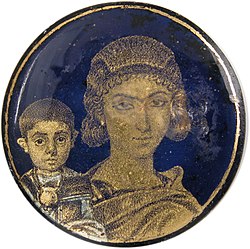
|
Metropolitan Museum of Art, New York City | early 4th century | 4.8 cm (1.9 in) in diameter | no inscription |
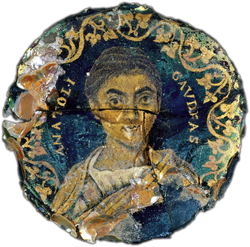
|
Corning Museum of Glass, Corning, New York | 3rd century | 4.9 cm (1.9 in) in diameter | Latin: ANATOLI GAVDIAS ("Anatolius, rejoice!") |

|
Victoria and Albert Museum, London | 3rd or 4th century | 4.4 cm (1.7 in) in diameter | no inscription |

|
British Museum, London | ? | 5.1 cm (2.0 in) in diameter | no inscription |

|
Archeological Museum, Bologna, Italy | 1st quarter of 4th century | 5.1 cm (2.0 in) in diameter | Latin transcription of Greek: PIE ZESES ("Drink and you will live") |
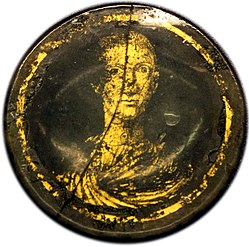
|
Archeological Museum, Bologna, Italy | 1st quarter of 4th century | 4.5 cm (1.8 in) in diameter | no inscription |

|
Archeological Museum, Bologna, Italy | 4th century | 3.5 cm (1.4 in) in diameter | Latin: M. COCCEIUS ONESIMUS (probably, the name of the boy) |

|
Archeological Museum, Arezzo, Italy | 200–250 | 4.4 cm (1.7 in) in diameter | no inscription |

|
Museo Sacro, Vatican Library | first half of the 3rd century | 4.9 cm (1.9 in) in diameter | Latin: GRECO RIBIBETPROPINATUIS (perhaps, "Gregory, drink and drink to thine") |

|
Vatican Library | ? | ? | no inscription |

|
Museo Sacro, Vatican Library | 3rd century | 4.8 cm (1.9 in) in diameter | Latin: EUSEBI ANIMA DULCIS (?) |

|
Vatican Museums | 3rd or 4th century | ? | Latin: GREGORI SIMPLICI CONRECESCATES (?) |

|
Catacomb of San Panfilo, Rome | 4th century or earlier | ? | no inscription |

|
Museo Civico, Turin, Italy | mid-3rd century | 4.5 cm (1.8 in) in diameter | no inscription |
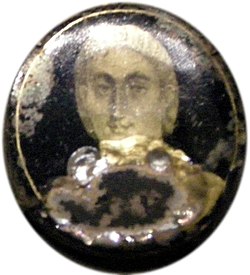
|
Museo Civico, Turin, Italy | 3rd century | ? | no inscription |

|
Vatican Museums | 17th-century copy of a lost original | ? | Latin: CE PIE ZESES ("Drink and you will live") |
Brescia medallion

The portrait medallion is a part of the ornamentation of the so-called Desiderius Cross, 9th-century processional crux gemmata currently preserved in Museo di Santa Giulia, Brescia, Italy.
The medallion is often referred to as a portrait of Galla Placidia and her children, but the current scholarly consensus is strongly against this 18th-century identification.
Some 19th-century scholars, including Raffaele Garrucci and Hermann Vopel, suspected the work to be a fake. The earliest mention of the medallion comes from a 17th-century inventory. In 1762, Francesco Antonio Zaccaria recalled that he saw it circa 1725.
Several details indicate the Egyptian, perhaps Alexandrian origin of the medallion. Both words of the inscription (ΒΟΥΝΝΕΡΙ ΚΕΡΑΜΙ) end in iota, possibly indicating the Ancient Greek dialect of Egypt; ΚΕΡΑΜΙ, then, means "potter". Stylistically, the painting is closely related to the 3rd-century mummy portraits found in the Faiyum Oasis. The costumes are more consistent with the contemporary fashions in Egypt than in Rome itself. In particular, the mantle worn by the middle figure is not fastened by a fibula, but instead knotted; one parallel for this is a 3rd-century Coptic tapestry medallion, now in the Hermitage Museum, showing the goddess Gaea with her mantle knotted in a similar way. The peculiar hair style of the older woman is unknown in Roman portraiture, but can be found on some 3rd-century plaster mummy masks from Egypt.
Howells (2015) summarizes the research into the Brescia medallion demonstrating its connection to contemporaneous Roman-Egyptian art (in particular the Fayum mummy portraits) as well as linguistic arguments supporting the authenticity of the artefact based on 18th century scholarship. Jás Elsner (2007) also contends that the Brescia medallion likely depicts a family from Alexandria, since the inscription is in the Alexandrian dialect of Greek, and provides possible dates ranging from the early-3rd to mid-5th century AD, before it found its way to Italy where it adorned a 7th-century cross.
-
Desiderius cross (enlarge the image to see the medallion in the centre of the lower part of the cross)
-
 Greek inscription, ΒΟΥΝΝΕΡΙ ΚΕΡΑΜΙ
Greek inscription, ΒΟΥΝΝΕΡΙ ΚΕΡΑΜΙ
-
 The middle figure, mantle knotted on her breast
The middle figure, mantle knotted on her breast
-
 Coptic tapestry medallion showing Gaea wearing a mantle knotted on her breast. From Akhmim, 3rd or 4th century. Hermitage Museum
Coptic tapestry medallion showing Gaea wearing a mantle knotted on her breast. From Akhmim, 3rd or 4th century. Hermitage Museum
-
 The right figure, with a hair style peculiar to Egypt
The right figure, with a hair style peculiar to Egypt
Ficoroni medallion

Fakes
Gold-glass forgeries are known to have been forged all through the 18th and 19th centuries. In 1759, French antiquarian Anne Claude de Caylus wrote that contemporary Roman dealers were selling gold-glass reproductions to tourists who thought them original. Metropolitan Museum of Art has what are thought to be two 18th-century fake group portraits, while the British Museum has two 19th-century ones.
-
 18th century
18th century
Metropolitan Museum of Art -
 18th century
18th century
Metropolitan Museum of Art -
 19th century
19th century
British Museum -
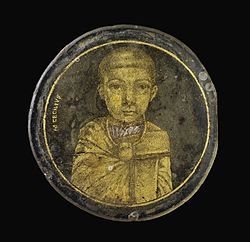 19th century
19th century
British Museum
See also
Notes
- ^ "Masterpieces. Desiderius' Cross". Fondazione Brescia Musei. Retrieved 4 December 2015.
- ^ Burns, Jasper. "The Brescia Medallion - Who, When, and Where?". Retrieved 4 December 2015.
- ^ Breck 1927, p. 353
- ^ "Medallion with a Portrait of Gennadios". Metropolitan Museum of Art. Retrieved 4 December 2015.
- Weitzmann 1979, p. 287
- Evans 2001, p. 9
- ^ "Gold Glass Medallion with a Mother and Child". Metropolitan Museum of Art. Retrieved 4 December 2015.
- ^ "Medallion with Portrait". Corning Museum of Glass. Retrieved 4 December 2015.
- ^ "Medallion (museum number: 1052-1868)". Victoria and Albert Museum. Retrieved 5 December 2015.
- ^ "disc / bowl (Museum number: 1890,0901.1)". British Museum. Retrieved 4 December 2015.
- ^ Egisto Sani (3 November 2013). "Golden Glass - II". flickr. Retrieved 7 December 2015.
- ^ Ducati 1929, pp. 236–240
- ^ Egisto Sani (3 November 2013). "Golden Glass". flickr. Retrieved 7 December 2015.
- Ducati 1929, p. 236
- ^ Ducati 1929, pp. 233–235
- "Emilia Romagna - BOLOGNA: MUSEO CIVICO ARCHEOLOGICO". Retrieved 8 December 2015.
Sezione romana: vetri dorati (IV sec.d.C.)
- ^ Lapatin 2015, p. 89 pl. 59, p. 237
- ^ Metropolitan Museum of Art 1982, p. 98
- Andrew Simsky. "Christian gold-glasses from the Vatican museum". Archived from the original on 27 April 2016. Retrieved 4 December 2015.
- "Vetro dorato con ritratto virile". ilsole24ore.com. Retrieved 5 December 2015.
- Lapatin 2015, p. 87 pl. 57
- ^ Lega 2012, p. 276 + p. 277 fig. 7a,b
- Lega 2012, p. 263
- ^ Whitehouse 1996, pp. 10–11
- ^ "ritrato femminile (Marcia Otacilia Severa?)". Palazzo Madama. Retrieved 7 December 2015.
- ^ Arte tardoromana, medaglione con figura femminile del II sec e con figura maschile del II-III sec.JPG shows the two Turin medallions together
- ^ Howells 2010, pp. 97–98
- Vaiani 2014, p. 244
- Garrucci 1795, pl. XLI p. 1, p. 84
- Garrucci 1858, p. 83; pl. XL, 7
- Vopel 1899, no. 507
- ^ Breck 1927, p. 354
- One example from the Metropolitan Museum of Art: link.
- Daniel Thomas Howells (2015). "A Catalogue of the Late Antique Gold Glass in the British Museum (PDF)." London: the British Museum (Arts and Humanities Research Council). Accessed 2 October 2016, p. 7: "Other important contributions to scholarship included the publication of an extensive summary of gold glass scholarship under the entry ‘Fonds de coupes’ in Fernand Cabrol and Henri Leclercq’s comprehensive Dictionnaire d’archéologie chrétienne et de liturgie in 1923. Leclercq updated Vopel’s catalogue, recording 512 gold glasses considered to be genuine, and developed a typological series consisting of eleven iconographic subjects: biblical subjects; Christ and the saints; various legends; inscriptions; pagan deities; secular subjects; male portraits; female portraits; portraits of couples and families; animals; and Jewish symbols. In a 1926 article devoted to the brushed technique gold glass known as the Brescia medallion (Pl. 1), Fernand de Mély challenged the deeply ingrained opinion of Garrucci and Vopel that all examples of brushed technique gold glass were in fact forgeries. The following year, de Mély’s hypothesis was supported and further elaborated upon in two articles by different scholars. A case for the Brescia medallion’s authenticity was argued for, not on the basis of its iconographic and orthographic similarity with pieces from Rome (a key reason for Garrucci’s dismissal), but instead for its close similarity to the Fayoum mummy portraits from Egypt. Indeed, this comparison was given further credence by Walter Crum’s assertion that the Greek inscription on the medallion was written in the Alexandrian dialect of Egypt. De Mély noted that the medallion and its inscription had been reported as early as 1725, far too early for the idiosyncrasies of Graeco-Egyptian word endings to have been understood by forgers." "Comparing the iconography of the Brescia medallion with other more closely dated objects from Egypt, Hayford Peirce then proposed that brushed technique medallions were produced in the early 3rd century, whilst de Mély himself advocated a more general 3rd-century date. With the authenticity of the medallion more firmly established, Joseph Breck was prepared to propose a late 3rd to early 4th century date for all of the brushed technique cobalt blue-backed portrait medallions, some of which also had Greek inscriptions in the Alexandrian dialect. Although considered genuine by the majority of scholars by this point, the unequivocal authenticity of these glasses was not fully established until 1941 when Gerhart Ladner discovered and published a photograph of one such medallion still in situ, where it remains to this day, impressed into the plaster sealing in an individual loculus in the Catacomb of Panfilo in Rome (Pl. 2). Shortly after in 1942, Morey used the phrase ‘brushed technique’ to categorize this gold glass type, the iconography being produced through a series of small incisions undertaken with a gem cutter’s precision and lending themselves to a chiaroscuro-like effect similar to that of a fine steel engraving simulating brush strokes."
- Jás Elsner (2007). "The Changing Nature of Roman Art and the Art Historical Problem of Style," in Eva R. Hoffman (ed), Late Antique and Medieval Art of the Medieval World, 11-18. Oxford, Malden & Carlton: Blackwell Publishing. ISBN 978-1-4051-2071-5, p. 17, Figure 1.3 on p. 18.
- "The immortal Alexander the Great". Hermitage Amsterdam. Archived from the original on 22 December 2015. Retrieved 10 December 2015.
- "Воображаемый музей". Retrieved 10 December 2015.
- Caylus 1759, p. 195, quote: "Ce moyen a été retrouvé à Rome, il y a très-peu d'années; j'en ai jugé par quelques morceaux très- bien traités: on s'en est servi pour tromper les Etrangers; mais celui qui possédoit ce petit secret est mort sans le publier"
- Breck 1927, pp. 353–354
- ^ "Medallion with Family Portrait (accession number: 17.190.108)". Metropolitan Museum of Art. Retrieved 8 December 2015.
- ^ "Medallion with Double Portrait (accession number: 17.190.107)". Metropolitan Museum of Art. Retrieved 8 December 2015.
- ^ "forgery / medallion (museum number: 1847,0824.2)". British Museum. Retrieved 8 December 2015.
- ^ "forgery / medallion (museum number: OA.10900)". British Museum. Retrieved 8 December 2015.
References
- Joseph Breck (1927). "The Ficoroni Medallion and Some Other Gilded Glasses in the Metropolitan Museum of Art". The Art Bulletin. 9 (4): 352–356. doi:10.2307/3046553. JSTOR 3046553.
- Anne Claude de Caylus (1795). Recueil d'antiquités égyptiennes, étrusques, grecques et romaines. Vol. III. Desant & Saillant. google books preview
- Pericle Ducati (1929). I vetri dorati romani nel Museo Civico di Bologna.
- Elsner, Jás (2007). "The Changing Nature of Roman Art and the Art Historical Problem of Style," in Eva R. Hoffman (ed), Late Antique and Medieval Art of the Medieval World, 11–18. Oxford, Malden & Carlton: Blackwell Publishing. ISBN 978-1-4051-2071-5.
- Helen C. Evans; Melanie Holcomb; Robert Hallman (2001). The Arts of Byzantium. New York City: Metropolitan Museum of Art.
- Raffaele Garrucci (1858). Vetri ornati di figure in oro: trovati nei cimiteri dei cristiani primitivi di Roma. Tipografia Salviucci. Internet Archive preview
- Howells, Daniel Thomas (2010). Late Antique Gold Glass in the British Museum, PhD Thesis.
- Howells, Daniel Thomas (2015). "A Catalogue of the Late Antique Gold Glass in the British Museum (PDF)." London: the British Museum (Arts and Humanities Research Council). Accessed 2 October 2016.
- Kenneth Lapatin (2015). Luxus: The Sumptuous Arts of Greece and Rome. Getty Publications. ISBN 9781606064221. google books preview
- Claudia Lega (2012). "Il corredo epigrafico dei vetri dorati: novità e considerazioni". Sylloge Epigraphica Barcinonensis. 10: 263–286.
- Metropolitan Museum of Art (1982). The Vatican Collections: The Papacy and Art. ISBN 0-87099-321-6.
- Elena Vaiani (2014). ""Clues to the ancient world": le piccole antichità nel Museo Cartaceo, con una verifica sulla collezione di Flavio Chigi" (PDF). Studi di Memofonte. Retrieved 8 December 2015.
- Hermann Vopel (1899). Die altchristlichen Goldgläser. J. C. B. Mohr. Retrieved 10 December 2015.
- Kurt Weitzmann, ed. (1979). Age of Spirituality: Late Antique and Early Christian Art, Third to Seventh Century. New York: Metropolitan Museum of Art. ISBN 9780870991790.
- David Whitehouse (1996). "Glass, Gold, and Gold-Glasses". Expedition. 38 (2): 4–12.
External links
- [REDACTED] Media related to Gold-glass portraits at Wikimedia Commons